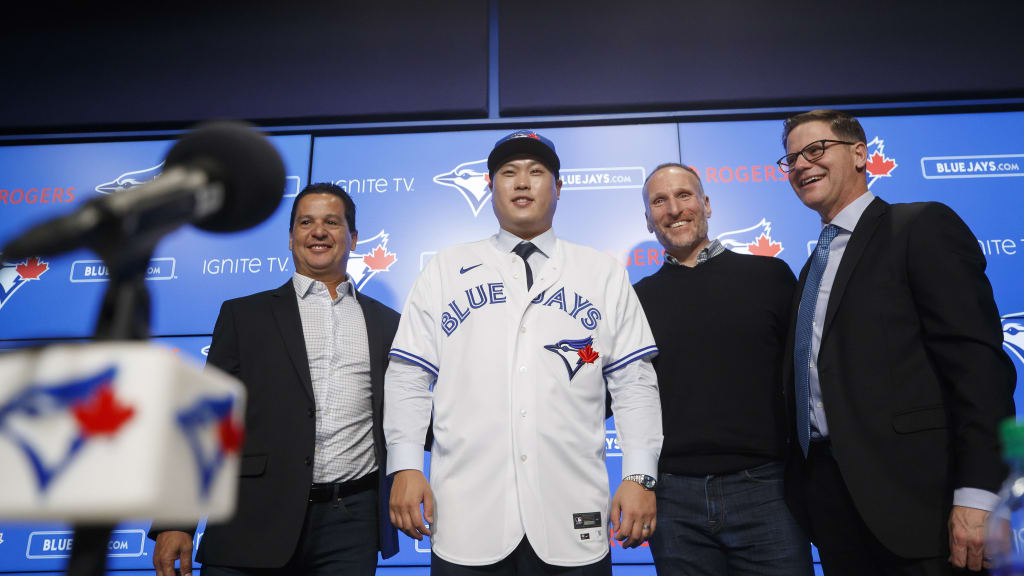
TORONTO -- New Blue Jays ace Hyun-Jin Ryu has a talent that requires more than just a quick glance to properly appreciate.
Built like a linebacker and throwing a fastball that averages just 90.7 mph, it would be easy to miscast Ryu as a depth starter if you stopped to watch him throw just a few pitches while passing a TV screen. A longer look, however, slowly reveals one of the game’s very best, a throwback lefty who embodies the difference between pitching and throwing.
Ryu’s wow factor lives in the box score, not on the radar gun.
“Speed is an important factor, but ever since I’ve been young, I’ve been focused on pitching as being more than just a fastball,” Ryu said through an interpreter. “If you throw it down the middle, they’re going to hit it. My repertoire of pitches, especially my changeup, has been key.”
Runner-up for the National League Cy Young Award in 2019, Ryu posted a Major League-low 2.32 ERA over 29 starts for the Dodgers, earning him a four-year, $80 million contract with the Blue Jays. The club has targeted depth heavily, but Ryu finally represents a big swing on upside -- great risk and all.
“It really stood out, his ability to command the ball so exceptionally well, get outs in every quadrant of the zone with four different pitchers,” Blue Jays general manager Ross Atkins said. “[Ryu’s] insane athleticism and just his ability on a field, it was something exceptional to watch.”
In the Minor Leagues, clubs are working to build future aces who look like Nate Pearson, Toronto’s No. 1 prospect per MLB Pipeline, who should join Ryu in the rotation at some point in 2020. Ryu exists much closer to the Mark Buehrle genre, though, and he makes it work without hitting triple digits. Here’s how:
The fastball-changeup combo
Ryu’s changeup and four-seamer were his two primary pitches in 2019, both being used just over 27 percent of the time, according to Statcast. With hitters forced to consider each of Ryu’s five pitches in any count, the velocity gap of 10.7 mph between his changeup and fastball becomes particularly challenging.
These pitches don’t need much velocity to move, either. Ryu’s fastball moves horizontally 3.4 inches more than the average pitcher’s, ranking him 57th of 432 qualified. When it comes to measuring the drop of Ryu’s changeup, his 36.8 inches of vertical movement places him 32nd among 291 qualified pitchers.
In simpler terms, Ryu’s two primary pitches move more than average, a talent that becomes much more valuable when his control is considered. Ryu throws 44.2 percent of his pitches on the edge of the zone, above the league average of 39 percent, a major reason he limited his walks to 1.2 per nine innings in 2019, the lowest among all qualified pitchers.
Adding a cutter
After adding a cutter in 2017, Ryu threw the pitch 19.4 percent of the time in '19. This is an example of how Ryu balances his pitching arsenal, which also includes a curveball with above-average movement and a sinker.
Ryu’s fastball and changeup are arm-side weapons for the lefty, meaning they’re often used inside against left-handed hitters or away from right-handed hitters. This cutter, which instead breaks in on right-handed hitters, allows Ryu to introduce yet another type of movement at 87 mph.
Defense matters
A pitcher who lives on the edges like Ryu benefits greatly from a catcher with strong framing skills. Russell Martin took care of that in L.A. for Ryu. Now it’s up to 2019 Gold Glove Award nominee Danny Jansen, who graded out well this past season, and Reese McGuire, who has a strong defensive reputation of his own.
The infield is where this gets interesting. Ryu’s ground-ball rate of 52.6 percent last season was a new career high, which meant taking advantage of the above-average defense behind him that included Corey Seager and Justin Turner. In Toronto, Ryu trades Turner for Vladimir Guerrero Jr., who ranked last among all qualified infielders with -16 Outs Above Average (OAA) in 2019. Cavan Biggio graded out well at second (+7 OAA), but shortstop Bo Bichette also has room to improve (-4 OAA).
